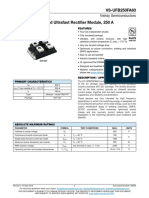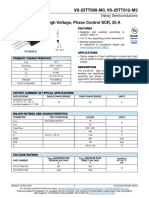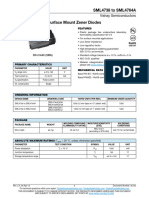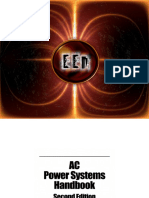Vs P400series
Vs P400series
Uploaded by
Jhonatan CastroCopyright:
Available Formats
Vs P400series
Vs P400series
Uploaded by
Jhonatan CastroOriginal Title
Copyright
Available Formats
Share this document
Did you find this document useful?
Is this content inappropriate?
Copyright:
Available Formats
Vs P400series
Vs P400series
Uploaded by
Jhonatan CastroCopyright:
Available Formats
VS-P400 Series
www.vishay.com
Vishay Semiconductors
Power Modules,
Passivated Assembled Circuit Elements, 40 A
FEATURES
• Glass passivated junctions for greater reliability
• Electrically isolated base plate
• Available up to 1200 VRRM/VDRM
• High dynamic characteristics
• Wide choice of circuit configurations
• Simplified mechanical design and assembly
• UL E78996 approved
PACE-PAK (D-19) • Material categorization: for definitions of compliance
please see www.vishay.com/doc?99912
PRIMARY CHARACTERISTICS DESCRIPTION
IO 40 A The VS-P400 series of integrated power circuits consists of
Type Modules - thyristor, standard power thyristors and power diodes configured in a single
Package PACE-PAK (D-19) package. With its isolating base plate, mechanical designs
are greatly simplified giving advantages of cost reduction
and reduced size.
Applications include power supplies, control circuits and
battery chargers.
MAJOR RATINGS AND CHARACTERISTICS
SYMBOL CHARACTERISTICS VALUES UNITS
IO 80 °C 40 A
ITSM, 50 Hz 385
A
IFSM 60 Hz 400
50 Hz 745
I2t A2s
60 Hz 680
I2t 7450 A2s
VRRM Range 400 to 1200 V
VISOL 2500 V
TJ
-40 to +125 °C
TStg
ELECTRICAL SPECIFICATIONS
VOLTAGE RATINGS
VRRM/VDRM, MAXIMUM VRSM, MAXIMUM
IRRM MAXIMUM
REPETITIVE PEAK REVERSE AND NON-REPETITIVE PEAK
TYPE NUMBER AT TJ MAXIMUM
PEAK OFF-STATE VOLTAGE REVERSE VOLTAGE
mA
V V
VS-P401, VS-P421, VS-P431 400 500
VS-P402, VS-P422, VS-P432 600 700
VS-P403, VS-P423, VS-P433 800 900 10
VS-P404, VS-P424, VS-P434 1000 1100
VS-P405, VS-P425, VS-P435 1200 1300
Revision: 27-Jul-2018 1 Document Number: 93755
For technical questions within your region: DiodesAmericas@vishay.com, DiodesAsia@vishay.com, DiodesEurope@vishay.com
THIS DOCUMENT IS SUBJECT TO CHANGE WITHOUT NOTICE. THE PRODUCTS DESCRIBED HEREIN AND THIS DOCUMENT
ARE SUBJECT TO SPECIFIC DISCLAIMERS, SET FORTH AT www.vishay.com/doc?91000
VS-P400 Series
www.vishay.com
Vishay Semiconductors
ON-STATE CONDUCTION
PARAMETER SYMBOL TEST CONDITIONS VALUES UNITS
Maximum DC output current 40 A
IO Full bridge circuits
at case temperature 80 °C
t = 10 ms No voltage 385
Maximum peak, one-cycle t = 8.3 ms reapplied 400
ITSM,
non-repetitive on-state or A
IFSM t = 10 ms 100 % VRRM 325
forward current
t = 8.3 ms reapplied Sinusoidal half wave, 340
t = 10 ms No voltage initial TJ = TJ maximum 745
t = 8.3 ms reapplied 680
Maximum I2t for fusing I2t A2s
t = 10 ms 100 % VRRM 530
t = 8.3 ms reapplied 480
t = 0.1 ms to 10 ms, no voltage reapplied
Maximum I2t for fusing I2t 7450 A2s
I2t for time tx = I2t · tx
Low level value of threshold voltage VT(TO)1 (16.7 % x x IT(AV) < I < x IT(AV)), TJ = TJ maximum 0.83
V
High level value of threshold voltage VT(TO)2 (I > x IT(AV)), TJ = TJ maximum 1.03
Low level value of on-state slope resistance rt1 (16.7 % x x IT(AV) < I < x IT(AV)), TJ = TJ maximum 9.61
m
High level value of on-state slope resistance rt2 (I > x IT(AV)), TJ = TJ maximum 7.01
Maximum on-state voltage drop VTM ITM = x IT(AV) TJ = 25 °C 1.4 V
Maximum forward voltage drop VFM IFM = x IF(AV) TJ = 25 °C 1.4 V
Maximum non-repetitive rate of rise of TJ = 125 °C from 0.67 VDRM
dI/dt 200 A/μs
turned-on current ITM = x IT(AV), Ig = 500 mA, tr < 0.5 μs, tp > 6 μs
Maximum holding current IH 130
TJ = 25 °C anode supply = 6 V, resistive load mA
Maximum latching current IL 250
BLOCKING
PARAMETER SYMBOL TEST CONDITIONS VALUES UNITS
Maximum critical rate of rise of
dV/dt TJ = 125 °C, exponential to 0.67 VDRM gate open 200 V/μs
off-state voltage
Maximum peak reverse and off-state IRRM,
TJ = 125 °C, gate open circuit 10 mA
leakage current at VRRM, VDRM IDRM
Maximum peak reverse leakage current IRRM TJ = 25 °C 100 μA
50 Hz, circuit to base, all terminals shorted,
RMS isolation voltage VISOL 2500 V
TJ = 25 °C, t = 1 s
TRIGGERING
PARAMETER SYMBOL TEST CONDITIONS VALUES UNITS
Maximum peak gate power PGM 8
W
Maximum average gate power PG(AV) 2
Maximum peak gate current IGM 2 A
Maximum peak negative gate voltage -VGM 10 V
TJ = - 40 °C 3
Maximum gate voltage required to trigger VGT TJ = 25 °C 2 V
TJ = 125 °C Anode supply = 1
TJ = - 40 °C 6 V resistive load 90
Maximum gate current required to trigger IGT TJ = 25 °C 60 mA
TJ = 125 °C 35
Maximum gate voltage that will not trigger VGD 0.2 V
TJ = 125 °C, rated VDRM applied
Maximum gate current that will not trigger IGD 2 mA
Revision: 27-Jul-2018 2 Document Number: 93755
For technical questions within your region: DiodesAmericas@vishay.com, DiodesAsia@vishay.com, DiodesEurope@vishay.com
THIS DOCUMENT IS SUBJECT TO CHANGE WITHOUT NOTICE. THE PRODUCTS DESCRIBED HEREIN AND THIS DOCUMENT
ARE SUBJECT TO SPECIFIC DISCLAIMERS, SET FORTH AT www.vishay.com/doc?91000
VS-P400 Series
www.vishay.com
Vishay Semiconductors
THERMAL AND MECHANICAL SPECIFICATIONS
PARAMETER SYMBOL TEST CONDITIONS VALUES UNITS
Maximum junction operating
TJ, TStg -40 to +125 °C
and storage temperature range
Maximum thermal resistance,
RthJC DC operation 1.05
junction to case per junction
K/W
Maximum thermal resistance,
RthCS Mounting surface, smooth and greased 0.10
case to heatsink
Mounting torque, base to heatsink (1) 4 Nm
58 g
Approximate weight
2.0 oz.
Case style PACE-PAK (D-19)
Note
(1) A mounting compound is recommended and the torque should be checked after a period of 3 hours to allow for the spread of the compound
120 120
+
Maximum Total Power Loss (W)
Maximum Total Power Loss (W)
~
100 100 R
th
- SA
=
1K 0.
80 80 /W 7
K/
W
1.5 -Δ
180° K/W R
60 60
(sine) 2K
/W
40 40 3 K/W
5 K/W
20 TJ = 125 °C 20
10 K/W
0 0
0 5 10 15 20 25 30 35 40 0 25 50 75 100 125
93755_01a Total Output Current (A) 93755_01b Maximum Allowable
Ambient Temperature (°C)
Fig. 1 - Current Ratings Nomogram (1 Module Per Heatsink)
30 40
Maximum Average On-State
Maximum Average On-State
35 DC
25
180° 180°
120° 30 120°
Power Loss (W)
Power Loss (W)
20 90° 90°
60° 25 60°
30° RMS limit 30° RMS limit
15 20
15
10
Ø Ø
Conduction angle 10 Conduction period
5 TJ = 125 °C TJ = 125 °C
Per junction 5 Per junction
0 0
0 5 10 15 20 0 5 10 15 20 25 30 35
93755_02 Average On-State Current (A) 93755_03 Average On-State Current (A)
Fig. 2 - On-State Power Loss Characteristics Fig. 3 - On-State Power Loss Characteristics
Revision: 27-Jul-2018 3 Document Number: 93755
For technical questions within your region: DiodesAmericas@vishay.com, DiodesAsia@vishay.com, DiodesEurope@vishay.com
THIS DOCUMENT IS SUBJECT TO CHANGE WITHOUT NOTICE. THE PRODUCTS DESCRIBED HEREIN AND THIS DOCUMENT
ARE SUBJECT TO SPECIFIC DISCLAIMERS, SET FORTH AT www.vishay.com/doc?91000
VS-P400 Series
www.vishay.com
Vishay Semiconductors
130 350
Fully turned-on At any rated load condition and with
325 rated VRRM applied following surge.
Maximum Allowable Case
120 Initial TJ = 125 °C
Peak Half Sine Wave
On-State Current (A)
300 at 60 Hz 0.0083 s
Temperature (°C)
110 180° at 50 Hz 0.0100 s
(Rect.) 275
100 180° 250
(Sine)
225
90
200
80
175 Per junction
Per module
70 150
0 5 10 15 20 25 30 35 40 45 1 10 100
93755_04 Total Output Current (A) 93755_06 Number of Equal Amplitude Half
Cycle Current Pulses (N)
Fig. 4 - Current Ratings Characteristics
Fig. 6 - Maximum Non-Repetitive Surge Current
1000 400
Instantaneous On-State Current (A)
Maximum non-repetitive surge current
TJ = 25 °C versus pulse train duration. Control of
On-State Current (A)
350 conduction may not be maintained.
Peak Half Sine Wave
Initial TJ = 125 °C
100 TJ = 125 °C No voltage reapplied
Rated VRRM reapplied
300
250
10
200
Per junction Per junction
1 150
0.5 1.0 1.5 2.0 2.5 3.0 3.5 4.0 4.5 5.0 0.01 0.1 1
93755_05 Instantaneous On-State Voltage (V) 93755_07 Pulse Train Duration (s)
Fig. 5 - On-State Voltage Drop Characteristics Fig. 7 - Maximum Non-Repetitive Surge Current
10
Steady state value
RthJC = 1.05 K/W
ZthJC - Transient Thermal
(DC operation)
Impedance (K/W)
Per junction
0.1
0.01
0.0001 0.001 0.01 0.1 1
93755_08 Square Wave Pulse Duration (s)
Fig. 8 - Thermal Impedance ZthJC Characteristics
Revision: 27-Jul-2018 4 Document Number: 93755
For technical questions within your region: DiodesAmericas@vishay.com, DiodesAsia@vishay.com, DiodesEurope@vishay.com
THIS DOCUMENT IS SUBJECT TO CHANGE WITHOUT NOTICE. THE PRODUCTS DESCRIBED HEREIN AND THIS DOCUMENT
ARE SUBJECT TO SPECIFIC DISCLAIMERS, SET FORTH AT www.vishay.com/doc?91000
VS-P400 Series
www.vishay.com
Vishay Semiconductors
100
Rectangular gate pulse (1) PGM = 10 W, tp = 5 ms
Instantaneous Gate Voltage (V)
(a) Recommended load line for (2) PGM = 20 W, tp = 25 ms
rated dI/dt: 10 V, 20 Ω, tr ≤ 1 μs (3) PGM = 50 W, tp = 1 ms
(b) Recommended load line for (4) PGM = 100 W, tp = 500 μs
10 rated dI/dt: 10 V, 65 Ω, tr ≤ 1 μs (a)
(b)
TJ = 25 °C
TJ = 125 °C
TJ = 40 °C
1
(1) (2) (3) (4)
VGD
Frequency limited by PG(AV)
IGD
0.1
0.001 0.01 0.1 1 10 100
93755_09 Instantaneous Gate Current (A)
Fig. 9 - Gate Characteristics
ORDERING INFORMATION TABLE
Device code VS- P 4 0 2 K W
1 2 3 4 5 6 7
1 - Vishay Semiconductors product
2 - Module type
3 - Current rating
1 = 25 A DC (P100 series)
4 = 40 A DC (P400 series)
4 - Circuit configuration
0 = single phase, hybrid bridge common cathode
2 = single phase, hybrid bridge doubler connection
3 = single phase, all SCR bridge
5 - Voltage code
1 = 400 V
2 = 600 V
3 = 800 V
4 = 1000 V
5 = 1200 V
6 - K = optional voltage suppression
7 - W = optional freewheeling diode
Revision: 27-Jul-2018 5 Document Number: 93755
For technical questions within your region: DiodesAmericas@vishay.com, DiodesAsia@vishay.com, DiodesEurope@vishay.com
THIS DOCUMENT IS SUBJECT TO CHANGE WITHOUT NOTICE. THE PRODUCTS DESCRIBED HEREIN AND THIS DOCUMENT
ARE SUBJECT TO SPECIFIC DISCLAIMERS, SET FORTH AT www.vishay.com/doc?91000
VS-P400 Series
www.vishay.com
Vishay Semiconductors
CIRCUIT CONFIGURATION
CIRCUIT
CIRCUIT DESCRIPTION CONFIGURATION SCHEMATIC DIAGRAM TERMINAL POSITIONS
CODE
G1
AC1
Single phase, hybrid bridge AC1 G1 -
0 AC2
common cathode
AC2 G2 +
G2
(-) (+)
G1 G2
AC2
Single phase, hybrid bridge AC1 G1 -
2 AC1
doubler connection
AC2 G2 +
(-) (+)
G3 G1
AC1
AC2 G2 -
Single phase, all SCR bridge 3 AC2
G1 G4
AC1 G3 +
G4 G2
(-) (+)
CODING (1)
WITH BOTH
CIRCUIT WITH
BASIC WITH VOLTAGE VOLTAGE SUPPRESSION
CIRCUIT DESCRIPTION CONFIGURATION FREEWHEELING
SERIES SUPPRESSION AND FREEWHEELING
CODE DIODE
DIODE
Single phase, hybrid bridge
0 P40. P40.K P40.W P40.KW
common cathode
Single phase, hybrid bridge
2 P42. P42.K - -
doubler connection
Single phase, all SCR bridge 3 P43. P43.K - -
Note
(1) To complete code refer to Voltage Ratings table, i.e.: for 600 V P40.W complete code is P402W
LINKS TO RELATED DOCUMENTS
Dimensions www.vishay.com/doc?95335
Revision: 27-Jul-2018 6 Document Number: 93755
For technical questions within your region: DiodesAmericas@vishay.com, DiodesAsia@vishay.com, DiodesEurope@vishay.com
THIS DOCUMENT IS SUBJECT TO CHANGE WITHOUT NOTICE. THE PRODUCTS DESCRIBED HEREIN AND THIS DOCUMENT
ARE SUBJECT TO SPECIFIC DISCLAIMERS, SET FORTH AT www.vishay.com/doc?91000
Outline Dimensions
Vishay Semiconductors
D-19 PACE-PAK
DIMENSIONS in millimeters (inches)
0.9 x 45°
(0.035 x 45°)
12.7 (0.50) 12.7 (0.50) Ø 1.65 (0.06)
4.6 (0.18)
25 (0.98) MAX.
15.5 (0.61)
MAX.
2.5 (0.10)
MAX.
63.5 (2.50)
Fast-on 6.35 x 0.8 (0.25 x 0.03)
45 (1.77)
23.2 (0.91) 5.2 (0.20) 32.5 (1.28) MAX.
33.8 (1.33)
48.7 (1.91)
Document Number: 95335 For technical questions, contact: indmodules@vishay.com www.vishay.com
Revision: 24-Jul-08 1
Legal Disclaimer Notice
www.vishay.com
Vishay
Disclaimer
ALL PRODUCT, PRODUCT SPECIFICATIONS AND DATA ARE SUBJECT TO CHANGE WITHOUT NOTICE TO IMPROVE
RELIABILITY, FUNCTION OR DESIGN OR OTHERWISE.
Vishay Intertechnology, Inc., its affiliates, agents, and employees, and all persons acting on its or their behalf (collectively,
“Vishay”), disclaim any and all liability for any errors, inaccuracies or incompleteness contained in any datasheet or in any other
disclosure relating to any product.
Vishay makes no warranty, representation or guarantee regarding the suitability of the products for any particular purpose or
the continuing production of any product. To the maximum extent permitted by applicable law, Vishay disclaims (i) any and all
liability arising out of the application or use of any product, (ii) any and all liability, including without limitation special,
consequential or incidental damages, and (iii) any and all implied warranties, including warranties of fitness for particular
purpose, non-infringement and merchantability.
Statements regarding the suitability of products for certain types of applications are based on Vishay's knowledge of typical
requirements that are often placed on Vishay products in generic applications. Such statements are not binding statements
about the suitability of products for a particular application. It is the customer's responsibility to validate that a particular product
with the properties described in the product specification is suitable for use in a particular application. Parameters provided in
datasheets and / or specifications may vary in different applications and performance may vary over time. All operating
parameters, including typical parameters, must be validated for each customer application by the customer's technical experts.
Product specifications do not expand or otherwise modify Vishay's terms and conditions of purchase, including but not limited
to the warranty expressed therein.
Hyperlinks included in this datasheet may direct users to third-party websites. These links are provided as a convenience and
for informational purposes only. Inclusion of these hyperlinks does not constitute an endorsement or an approval by Vishay of
any of the products, services or opinions of the corporation, organization or individual associated with the third-party website.
Vishay disclaims any and all liability and bears no responsibility for the accuracy, legality or content of the third-party website
or for that of subsequent links.
Except as expressly indicated in writing, Vishay products are not designed for use in medical, life-saving, or life-sustaining
applications or for any other application in which the failure of the Vishay product could result in personal injury or death.
Customers using or selling Vishay products not expressly indicated for use in such applications do so at their own risk. Please
contact authorized Vishay personnel to obtain written terms and conditions regarding products designed for such applications.
No license, express or implied, by estoppel or otherwise, to any intellectual property rights is granted by this document or by
any conduct of Vishay. Product names and markings noted herein may be trademarks of their respective owners.
© 2023 VISHAY INTERTECHNOLOGY, INC. ALL RIGHTS RESERVED
Revision: 01-Jan-2023 1 Document Number: 91000
You might also like
- SCS, Lascr, Diac and TriacDocument16 pagesSCS, Lascr, Diac and TriacRyan Paul RiwarinNo ratings yet
- Standard Recovery Diodes: JZZX860D (U) .. SeriesDocument3 pagesStandard Recovery Diodes: JZZX860D (U) .. SeriesJose Castro100% (1)
- ZVS and ZCS Resonant ConverterDocument79 pagesZVS and ZCS Resonant ConverterKaumil100% (1)
- Operating Instructions: Standard Converter - Cabinet Type UNL133Document32 pagesOperating Instructions: Standard Converter - Cabinet Type UNL133yusuf yusufNo ratings yet
- Unit 5 - Simulation of HVDC SystemDocument24 pagesUnit 5 - Simulation of HVDC Systemkarthik60% (10)
- VS-P100 Series: Vishay SemiconductorsDocument8 pagesVS-P100 Series: Vishay SemiconductorsjavitasNo ratings yet
- Vs-Vskt320Pbf Series: Vishay SemiconductorsDocument7 pagesVs-Vskt320Pbf Series: Vishay SemiconductorsRyu DanNo ratings yet
- Vs-Vsk.230..Pbf Series: Vishay SemiconductorsDocument9 pagesVs-Vsk.230..Pbf Series: Vishay SemiconductorsrenidwilNo ratings yet
- Datasheetpower DiodesDocument14 pagesDatasheetpower DiodesJose ManuelNo ratings yet
- To 247ac Anexa Tiristor BunaDocument8 pagesTo 247ac Anexa Tiristor BunanumaionelNo ratings yet
- Vs vskd600Document8 pagesVs vskd600mohammed shantiNo ratings yet
- VS-MB Series: Vishay SemiconductorsDocument7 pagesVS-MB Series: Vishay SemiconductorsMohammed Mosaad LyricsNo ratings yet
- Vs 40mt160ppbf 38037Document10 pagesVs 40mt160ppbf 3803719thmnlfreemsNo ratings yet
- VS 36mb100aDocument7 pagesVS 36mb100aatu wentNo ratings yet
- VSKTF180-Vishay SiliconixDocument9 pagesVSKTF180-Vishay Siliconixสุทธิชัย การด่วนNo ratings yet
- DIODES Vs 36mtseriesDocument7 pagesDIODES Vs 36mtserieshocine gherbiNo ratings yet
- VS-40TPS... - M3 Series: Vishay SemiconductorsDocument8 pagesVS-40TPS... - M3 Series: Vishay SemiconductorsDaniel ConstantinNo ratings yet
- VS-150U (R) .. Series: Vishay SemiconductorsDocument7 pagesVS-150U (R) .. Series: Vishay SemiconductorsRoserox25No ratings yet
- Vs vsk91Document9 pagesVs vsk91johnscuizonNo ratings yet
- VSKT106 16S90P VishayDocument9 pagesVSKT106 16S90P VishayjoseNo ratings yet
- Vs-70Tps12Pbf, Vs-70Tps16Pbf High Voltage Series: Vishay SemiconductorsDocument8 pagesVs-70Tps12Pbf, Vs-70Tps16Pbf High Voltage Series: Vishay SemiconductorsHenry JoseNo ratings yet
- Vishay Semiconductors: FeaturesDocument4 pagesVishay Semiconductors: FeaturesAhmed Sherif CupoNo ratings yet
- VS-KBPC1, VS-KBPC6 Series: Vishay SemiconductorsDocument5 pagesVS-KBPC1, VS-KBPC6 Series: Vishay SemiconductorsYaraNo ratings yet
- 40TPS12A-Vishay SiliconixDocument7 pages40TPS12A-Vishay SiliconixWuryAgusNo ratings yet
- Fast Recovery Diodes VS-SD303C25S20CDocument9 pagesFast Recovery Diodes VS-SD303C25S20CFay AgodoloNo ratings yet
- Diode 200 V5 ADocument6 pagesDiode 200 V5 AHjetoNo ratings yet
- Vs-St230cseries (SCR Driver Mentor)Document8 pagesVs-St230cseries (SCR Driver Mentor)Roger VicenteNo ratings yet
- VST 20 HF 220Document6 pagesVST 20 HF 22018EE25 - G.Sharan KrishnanNo ratings yet
- 36MT10Document8 pages36MT10filipe AugustoNo ratings yet
- VS-85HF (R) 40M8: Vishay SemiconductorsDocument8 pagesVS-85HF (R) 40M8: Vishay SemiconductorsDIPIN PNo ratings yet
- kbpc1 102709Document5 pageskbpc1 102709RosmarieNo ratings yet
- VS 80CPQ150PbFDocument7 pagesVS 80CPQ150PbFSchueler TecnologiaNo ratings yet
- ST330C16Document9 pagesST330C16Bruno NevesNo ratings yet
- 1101-808-1 Datasheets USDocument4 pages1101-808-1 Datasheets USJOSE BNo ratings yet
- VS-30TPS16-M3: Vishay SemiconductorsDocument7 pagesVS-30TPS16-M3: Vishay SemiconductorsMohamed ReyadNo ratings yet
- SCR 25 A 1795519Document7 pagesSCR 25 A 1795519dodifirmanNo ratings yet
- A50QSDocument4 pagesA50QSYesidNo ratings yet
- Diiodo TarjetaDocument6 pagesDiiodo TarjetaSergio Andres Varas ValeroNo ratings yet
- DIODODocument8 pagesDIODOluis montacargasNo ratings yet
- 70TPS.. High Voltage Series: Vishay High Power ProductsDocument7 pages70TPS.. High Voltage Series: Vishay High Power ProductsL oNo ratings yet
- Vs 130mt80k-1769090Document9 pagesVs 130mt80k-1769090DYLAN JOSUE (SOLUCIONES TECNOLOGICA)No ratings yet
- Ultrafast Rectifier Module Vs-Ufb250fa60Document8 pagesUltrafast Rectifier Module Vs-Ufb250fa60Fay AgodoloNo ratings yet
- D vs-40tts12pbf TDocument7 pagesD vs-40tts12pbf TtadyNo ratings yet
- Litlle FuseDocument20 pagesLitlle Fusefassina01No ratings yet
- 12kV Air Insulated Metal Clad Switchgear PanelDocument2 pages12kV Air Insulated Metal Clad Switchgear PanelHarmanPreetNo ratings yet
- VS-40CPQ... - N3 Series: Vishay SemiconductorsDocument7 pagesVS-40CPQ... - N3 Series: Vishay SemiconductorsaadNo ratings yet
- VO14642AT, VO14642AABTR 1 Form A Solid-State Relay: Vishay SemiconductorsDocument11 pagesVO14642AT, VO14642AABTR 1 Form A Solid-State Relay: Vishay SemiconductorskktmhaziqNo ratings yet
- Vs 25tts0812 m3Document7 pagesVs 25tts0812 m3luuk.wNo ratings yet
- A70QSDocument4 pagesA70QSYesidNo ratings yet
- ST1200C16K1LDocument9 pagesST1200C16K1LcomprasNo ratings yet
- Air Circuit Breakers-AHA Type PDFDocument8 pagesAir Circuit Breakers-AHA Type PDFJince LawranceNo ratings yet
- MENNEKES Full Line CatalogDocument80 pagesMENNEKES Full Line CatalogUmer FarNo ratings yet
- VSMB3940X01: Vishay SemiconductorsDocument6 pagesVSMB3940X01: Vishay SemiconductorsAnoop C PatilNo ratings yet
- MediaDocument20 pagesMediaKarthikeyan GuruNo ratings yet
- RM ST40Document2 pagesRM ST40LUIS SLEITER NAPÁN HUAMANÍNo ratings yet
- WEG DWB 50070240 en PDFDocument56 pagesWEG DWB 50070240 en PDFwil alfNo ratings yet
- Diodo Entrada Digital SML4756, Marking Code 47Document6 pagesDiodo Entrada Digital SML4756, Marking Code 47samuelborgesNo ratings yet
- Vishay St223c04cfl1 Datasheets 3531Document10 pagesVishay St223c04cfl1 Datasheets 3531Mirko CoppiniNo ratings yet
- 30Tps... PBF High Voltage Series: Vishay High Power ProductsDocument8 pages30Tps... PBF High Voltage Series: Vishay High Power ProductsBladeNo ratings yet
- 1000SDIM2064rev01 ENGDocument34 pages1000SDIM2064rev01 ENGbigeyes1986No ratings yet
- Thyristor 50A 600V 50RIADocument7 pagesThyristor 50A 600V 50RIAtrooperNo ratings yet
- Rhenes ACB PDFDocument11 pagesRhenes ACB PDFRojan RegmiNo ratings yet
- Uk Exs Xl-Series DsDocument4 pagesUk Exs Xl-Series DsAndzar Muhammad FauziNo ratings yet
- Class 2 SyllabusDocument17 pagesClass 2 SyllabusKichaaNo ratings yet
- Gefran 600 Pidcontroler ManualDocument30 pagesGefran 600 Pidcontroler ManualOrlando David Zeña SandovalNo ratings yet
- Thyristor 50A 600V 50RIADocument7 pagesThyristor 50A 600V 50RIAtrooperNo ratings yet
- Power Electronics - QB - Final - PECDocument52 pagesPower Electronics - QB - Final - PECmanoj kumarNo ratings yet
- Slewing Controller SpecificationDocument7 pagesSlewing Controller SpecificationMohamed ElsayedNo ratings yet
- Redressement Contrôlé Monophasé Simple Alternance: Exercice 1Document4 pagesRedressement Contrôlé Monophasé Simple Alternance: Exercice 1Ay OùbNo ratings yet
- Power Electronics MitDocument210 pagesPower Electronics MitSusmita AdhikaryNo ratings yet
- Thyristor Converters or Controlled Converters: (1) Power CircuitDocument55 pagesThyristor Converters or Controlled Converters: (1) Power CircuitAbdullrahman Al-ShammaaNo ratings yet
- Analysis and Design of Power Electronic Circuits Using OrcadDocument39 pagesAnalysis and Design of Power Electronic Circuits Using OrcadMari MuthuNo ratings yet
- An Overview of Electromagnetic and Lightning Induced Voltage TransientsDocument11 pagesAn Overview of Electromagnetic and Lightning Induced Voltage TransientsRavishankar PmNo ratings yet
- Drmos BLN01G52 Aoz5311 RTX3070Document18 pagesDrmos BLN01G52 Aoz5311 RTX3070techgamebr85No ratings yet
- Mac97a6 PDFDocument7 pagesMac97a6 PDFLuis Eduardo RibeiroNo ratings yet
- 01 LTC CardDocument14 pages01 LTC CardAnujGargNo ratings yet
- C-2007-Induction Motor Drive Using Fuzzy LogicDocument9 pagesC-2007-Induction Motor Drive Using Fuzzy LogicshahramjNo ratings yet
- AC Power Systems Handbook Second Edition - CRC PDFDocument564 pagesAC Power Systems Handbook Second Edition - CRC PDFnicu h100% (1)
- IC Control Thy - TCA 785Document5 pagesIC Control Thy - TCA 785apriliaa ayuuNo ratings yet
- BSc-III ElectronicsDocument37 pagesBSc-III ElectronicsmvkgayatrishivaniNo ratings yet
- Tutorial 3 - Phase Controlled AC-DC ConvertersDocument3 pagesTutorial 3 - Phase Controlled AC-DC ConvertersChangyuFuNo ratings yet
- Gate Characteristics Design Thyristor Ratings Requirements of The Gate CircuitDocument9 pagesGate Characteristics Design Thyristor Ratings Requirements of The Gate CircuitAayu JainNo ratings yet
- D 8020 L RectifierDocument4 pagesD 8020 L RectifierhdquanNo ratings yet
- Sinamics Perfect Harmony gh180 Catalog d17 v34 12 2022Document88 pagesSinamics Perfect Harmony gh180 Catalog d17 v34 12 2022Teddy NickolayevskyNo ratings yet
- SCMM - 25-35-95 - D2249 - 1660405 - Water Boiler PN.62197-001-001Document145 pagesSCMM - 25-35-95 - D2249 - 1660405 - Water Boiler PN.62197-001-001kisaranontakulNo ratings yet
- Iec 60617 SymbolsDocument53 pagesIec 60617 SymbolsAnonymous r3MoX2ZMT100% (2)
- Crossword 4 SolutionDocument1 pageCrossword 4 SolutionAmit BaliNo ratings yet
- SCR 1Document21 pagesSCR 1Prasun MoyraNo ratings yet
- Transp VDocument40 pagesTransp VlacrimogenoNo ratings yet
























































































